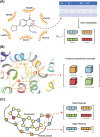An overview of recent advances and challenges in predicting compound-protein interaction (CPI)
- PMID: 38282802
- PMCID: PMC10808869
- DOI: 10.1515/mr-2023-0030
An overview of recent advances and challenges in predicting compound-protein interaction (CPI)
Abstract
Compound-protein interactions (CPIs) are critical in drug discovery for identifying therapeutic targets, drug side effects, and repurposing existing drugs. Machine learning (ML) algorithms have emerged as powerful tools for CPI prediction, offering notable advantages in cost-effectiveness and efficiency. This review provides an overview of recent advances in both structure-based and non-structure-based CPI prediction ML models, highlighting their performance and achievements. It also offers insights into CPI prediction-related datasets and evaluation benchmarks. Lastly, the article presents a comprehensive assessment of the current landscape of CPI prediction, elucidating the challenges faced and outlining emerging trends to advance the field.
Keywords: artificial intelligence; chemogenomics; compound-protein interaction prediction; drug discovery; scoring function.
© 2023 the author(s), published by De Gruyter, Berlin/Boston.
Conflict of interest statement
Competing interests: Authors state no conflict of interest.
Figures




Similar articles
-
A general prediction model for compound-protein interactions based on deep learning.Front Pharmacol. 2024 Sep 4;15:1465890. doi: 10.3389/fphar.2024.1465890. eCollection 2024. Front Pharmacol. 2024. PMID: 39295942 Free PMC article.
-
Effectively Identifying Compound-Protein Interactions by Learning from Positive and Unlabeled Examples.IEEE/ACM Trans Comput Biol Bioinform. 2018 Nov-Dec;15(6):1832-1843. doi: 10.1109/TCBB.2016.2570211. Epub 2016 May 18. IEEE/ACM Trans Comput Biol Bioinform. 2018. PMID: 28113437
-
A deep learning method for predicting molecular properties and compound-protein interactions.J Mol Graph Model. 2022 Dec;117:108283. doi: 10.1016/j.jmgm.2022.108283. Epub 2022 Aug 17. J Mol Graph Model. 2022. PMID: 35994925
-
A review on compound-protein interaction prediction methods: Data, format, representation and model.Comput Struct Biotechnol J. 2021 Mar 10;19:1541-1556. doi: 10.1016/j.csbj.2021.03.004. eCollection 2021. Comput Struct Biotechnol J. 2021. PMID: 33841755 Free PMC article. Review.
-
Compound-protein interaction prediction by deep learning: Databases, descriptors and models.Drug Discov Today. 2022 May;27(5):1350-1366. doi: 10.1016/j.drudis.2022.02.023. Epub 2022 Mar 3. Drug Discov Today. 2022. PMID: 35248748 Review.
Cited by
-
Accelerating drug discovery and repurposing by combining transcriptional signature connectivity with docking.Sci Adv. 2024 Aug 30;10(35):eadj3010. doi: 10.1126/sciadv.adj3010. Epub 2024 Aug 30. Sci Adv. 2024. PMID: 39213358 Free PMC article.
-
Mapping protein-metabolite interactions in E. coli by integrating chromatographic techniques and co-fractionation mass spectrometry.iScience. 2025 May 8;28(6):112611. doi: 10.1016/j.isci.2025.112611. eCollection 2025 Jun 20. iScience. 2025. PMID: 40491478 Free PMC article.
-
In silico off-target profiling for enhanced drug safety assessment.Acta Pharm Sin B. 2024 Jul;14(7):2927-2941. doi: 10.1016/j.apsb.2024.03.002. Epub 2024 Mar 6. Acta Pharm Sin B. 2024. PMID: 39027254 Free PMC article.
-
BioStructNet: Structure-Based Network with Transfer Learning for Predicting Biocatalyst Functions.J Chem Theory Comput. 2025 Jan 14;21(1):474-490. doi: 10.1021/acs.jctc.4c01391. Epub 2024 Dec 20. J Chem Theory Comput. 2025. PMID: 39705058 Free PMC article.
References
Publication types
LinkOut - more resources
Full Text Sources
